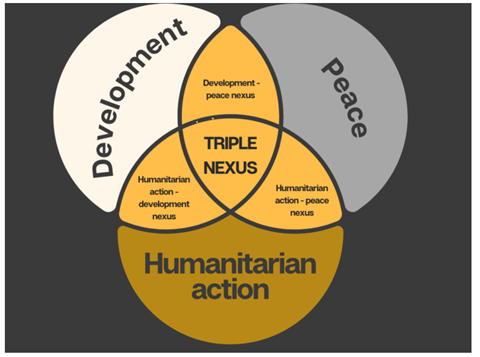The Humanitarian Development Nexus

What is the Humanitarian-Development Nexus?
The humanitarian-development nexus is the bridging of emergency humanitarian aid and longer-term development assistance to provide complementary and connected assistance for people affected by crises.
As crises become increasingly protracted and recurrent, increased collaboration between humanitarian and development actors is needed to address the underlying poverty and vulnerabilities that prevent communities from being resilient and able to recover from disasters quickly.
How Cash and Voucher Assistance (CVA) relates to the Humanitarian-Development Nexus
As cash and voucher assistance (CVA) is used in both humanitarian and development contexts, it provides an opportunity to improve the connection between these areas of work – often referred to as the humanitarian-development nexus.
CVA can be used to link these two approaches through:
- Building resilience: CVA is often used in disaster preparedness to help improve the resilience of communities at risk, such as providing cash for building flood protection measures.
- Connecting the nexus: CVA can help humanitarian aid and social protection reach their complementary goals of protecting and preventing risks for vulnerable people. Better connections between the two can help target and reach people more efficiently.
- Coordination and partnership: CVA encourages better partnerships between humanitarian actors and governments, such as connecting emergency transfers to existing social protection systems. Equally, it helps links with non-governmental development actors involved in longer term work.
Examples of CVA supporting the humanitarian-development nexus:
- Oxfam’s triple nexus programming incorporates cash transfers to help address the underlying drivers of conflict, vulnerability and the root causes of the risks people face. Their Emergency Food Security and Vulnerable Livelihoods programme combines cash transfers to cover immediate basic needs, with temporary employment to build economic resilience.
- An government, NGO and UN consortium humanitarian-development programme in Somalia aims to provide long-term support to households with chronic food insecurity. The project helped the Federal Government of Somalia put in place Baxnaano, a shock-responsive social protection system. More than one million people now receive unconditional cash transfers through the system, which is designed to scale up to provide emergency cash transfers during emergencies. For example, in 2020, Baxaano provided emergency cash to support 600,000 people during a major locust swarm.
Learn more about the connection between social protection and humanitarian CVA on the Cash 101.
More about the nexus
Humanitarian-development nexus challenges
The humanitarian-development nexus has often faced criticism about mission creep of humanitarian actors, stretching of funds, and how to make it work in practice. Another challenge is how to bring together the humanitarian principles of neutrality, humanity, impartiality, and independence with the long-term political, rights-based approaches of development.
This issue can be particularly acute when it comes to government relationships. Many development actors work with and through state actors, whereas humanitarians in many situations, especially conflict situations with many warring parties, need to stay neutral.
Other challenges include the difficulty to align frameworks and plans that guide humanitarian and development work and the lack of funding instruments for multi-year flexible funding across both areas of work.
What is the triple nexus?
The triple nexus is when humanitarian, development and peacebuilding actors come together to help people affected by crises. In 2016, UN Secretary-General António Guterres called for “sustaining peace” to be included as the “third leg of the triangle” with humanitarian and development to make the triple nexus.

The triple nexus suggests the war-to-peace transition is a continuum that shouldn’t be compartmentalised. People affected by these crises do not categorise their needs into sectors, so humanitarian, development and peace actors need to cooperate no matter how a situation is defined.
A New Way of Working: The Key Concepts
Following the World Humanitarian Summit in 2016, the UN Secretary General put forward the Agenda for Humanity, a set of priority actions for humanitarian actors. This included the ‘New Way of Working’, a call for humanitarian and development actors to work collaboratively together towards ‘collective outcomes’ that reduce need, risk, and vulnerability over multiple years.
The New Way of Working aims to assist over multiple years, with a diverse range of actors, to find solutions for long- and short-term crises.
Find out more about the connection between CVA and Development on the Cash 101.